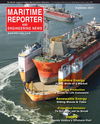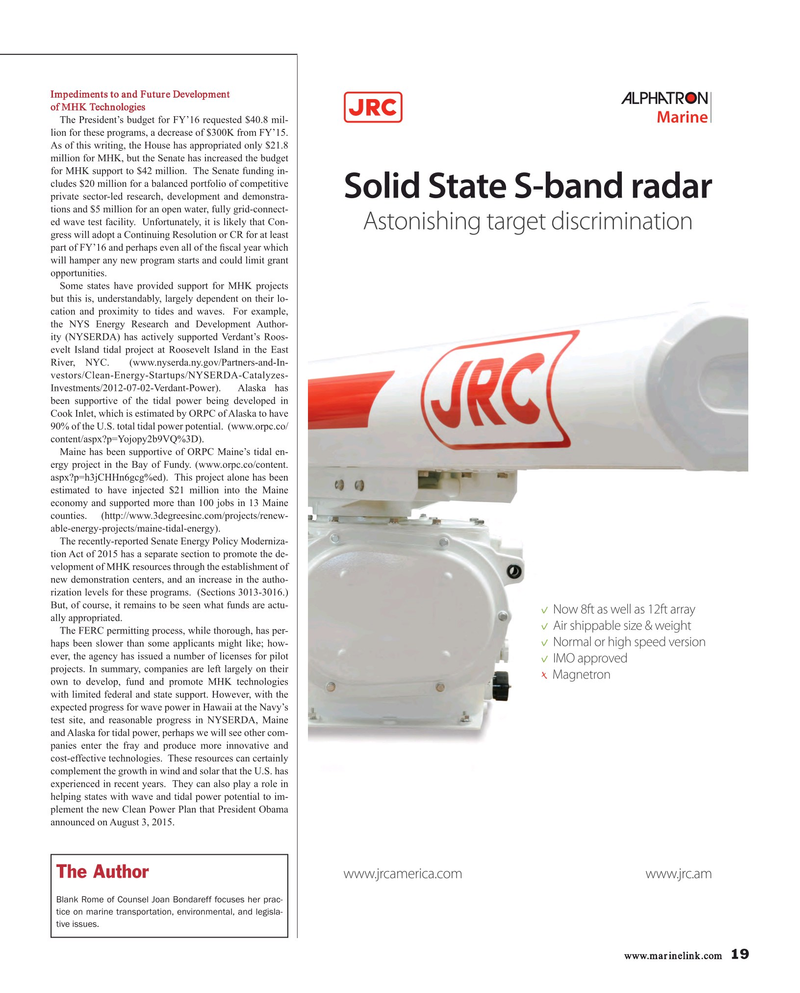
Page 19: of Maritime Reporter Magazine (September 2015)
Offshore Energy Technologies
Read this page in Pdf, Flash or Html5 edition of September 2015 Maritime Reporter Magazine
Impediments to and Future Development of MHK Technologies
The President’s budget for FY’16 requested $40.8 mil- lion for these programs, a decrease of $300K from FY’15.
As of this writing, the House has appropriated only $21.8 million for MHK, but the Senate has increased the budget for MHK support to $42 million. The Senate funding in- cludes $20 million for a balanced portfolio of competitive
Solid State S-band radar private sector-led research, development and demonstra- tions and $5 million for an open water, fully grid-connect- ed wave test facility. Unfortunately, it is likely that Con-
Astonishing target discrimination gress will adopt a Continuing Resolution or CR for at least part of FY’16 and perhaps even all of the ? scal year which will hamper any new program starts and could limit grant opportunities.
Some states have provided support for MHK projects but this is, understandably, largely dependent on their lo- cation and proximity to tides and waves. For example, the NYS Energy Research and Development Author- ity (NYSERDA) has actively supported Verdant’s Roos- evelt Island tidal project at Roosevelt Island in the East
River, NYC. (www.nyserda.ny.gov/Partners-and-In- vestors/Clean-Energy-Startups/NYSERDA-Catalyzes-
Investments/2012-07-02-Verdant-Power). Alaska has been supportive of the tidal power being developed in
Cook Inlet, which is estimated by ORPC of Alaska to have 90% of the U.S. total tidal power potential. (www.orpc.co/ content/aspx?p=Yojopy2b9VQ%3D).
Maine has been supportive of ORPC Maine’s tidal en- ergy project in the Bay of Fundy. (www.orpc.co/content.
aspx?p=h3jCHHn6gcg%ed). This project alone has been estimated to have injected $21 million into the Maine economy and supported more than 100 jobs in 13 Maine counties. (http://www.3degreesinc.com/projects/renew- able-energy-projects/maine-tidal-energy).
The recently-reported Senate Energy Policy Moderniza- tion Act of 2015 has a separate section to promote the de- velopment of MHK resources through the establishment of new demonstration centers, and an increase in the autho- rization levels for these programs. (Sections 3013-3016.)
But, of course, it remains to be seen what funds are actu- v Now 8ft as well as 12ft array ally appropriated. v Air shippable size & weight
The FERC permitting process, while thorough, has per- v Normal or high speed version haps been slower than some applicants might like; how- ever, the agency has issued a number of licenses for pilot v IMO approved projects. In summary, companies are left largely on their x Magnetron own to develop, fund and promote MHK technologies with limited federal and state support. However, with the expected progress for wave power in Hawaii at the Navy’s test site, and reasonable progress in NYSERDA, Maine and Alaska for tidal power, perhaps we will see other com- panies enter the fray and produce more innovative and cost-effective technologies. These resources can certainly complement the growth in wind and solar that the U.S. has experienced in recent years. They can also play a role in helping states with wave and tidal power potential to im- plement the new Clean Power Plan that President Obama announced on August 3, 2015.
The Author www.jrcamerica.com www.jrc.am
Blank Rome of Counsel Joan Bondareff focuses her prac- www.jrc.am tice on marine transportation, environmental, and legisla- tive issues.
www.marinelink.com 19
MR #9 (18-25).indd 19 MR #9 (18-25).indd 19 9/3/2015 10:39:39 AM9/3/2015 10:39:39 AM

 18
18

 20
20
